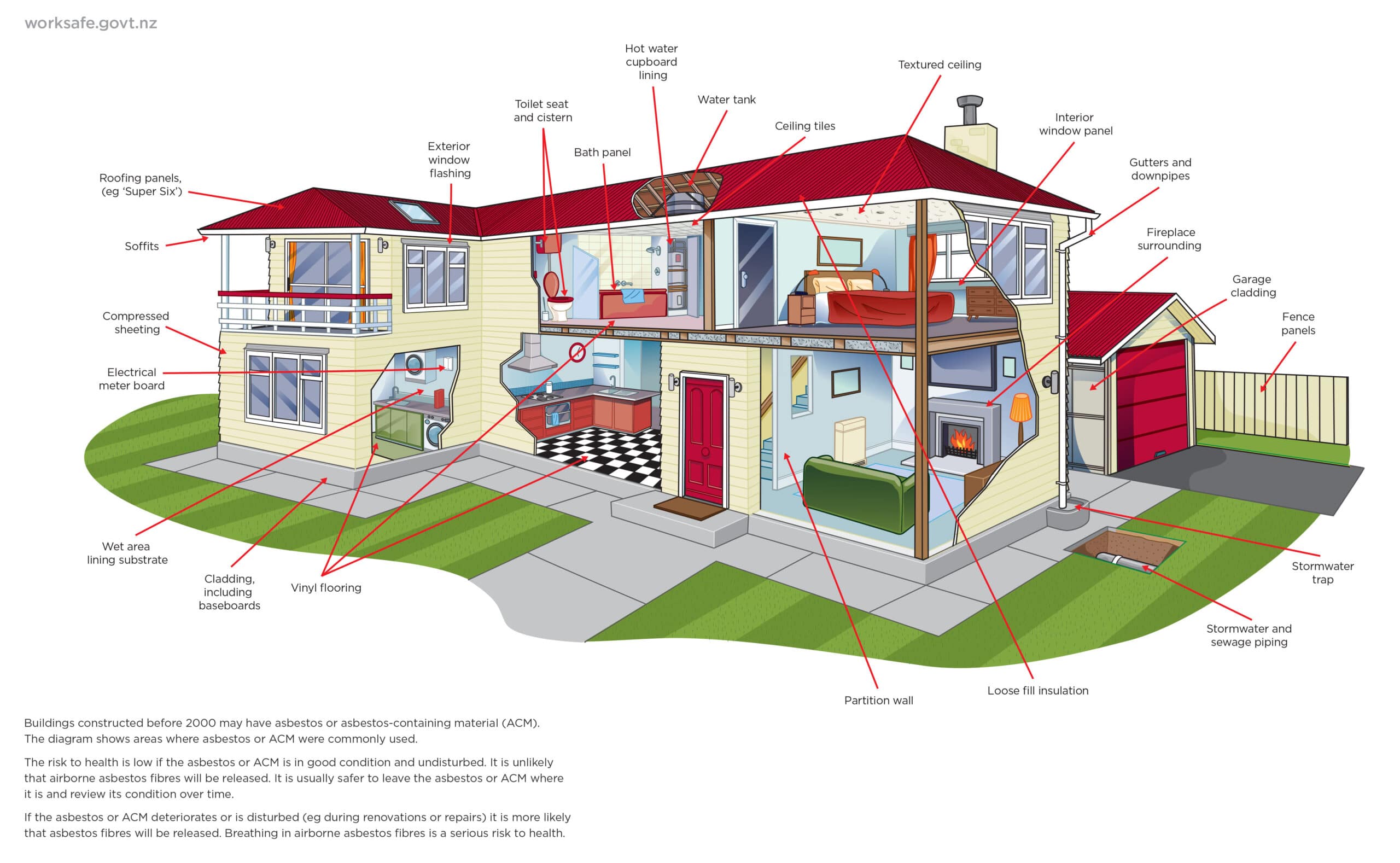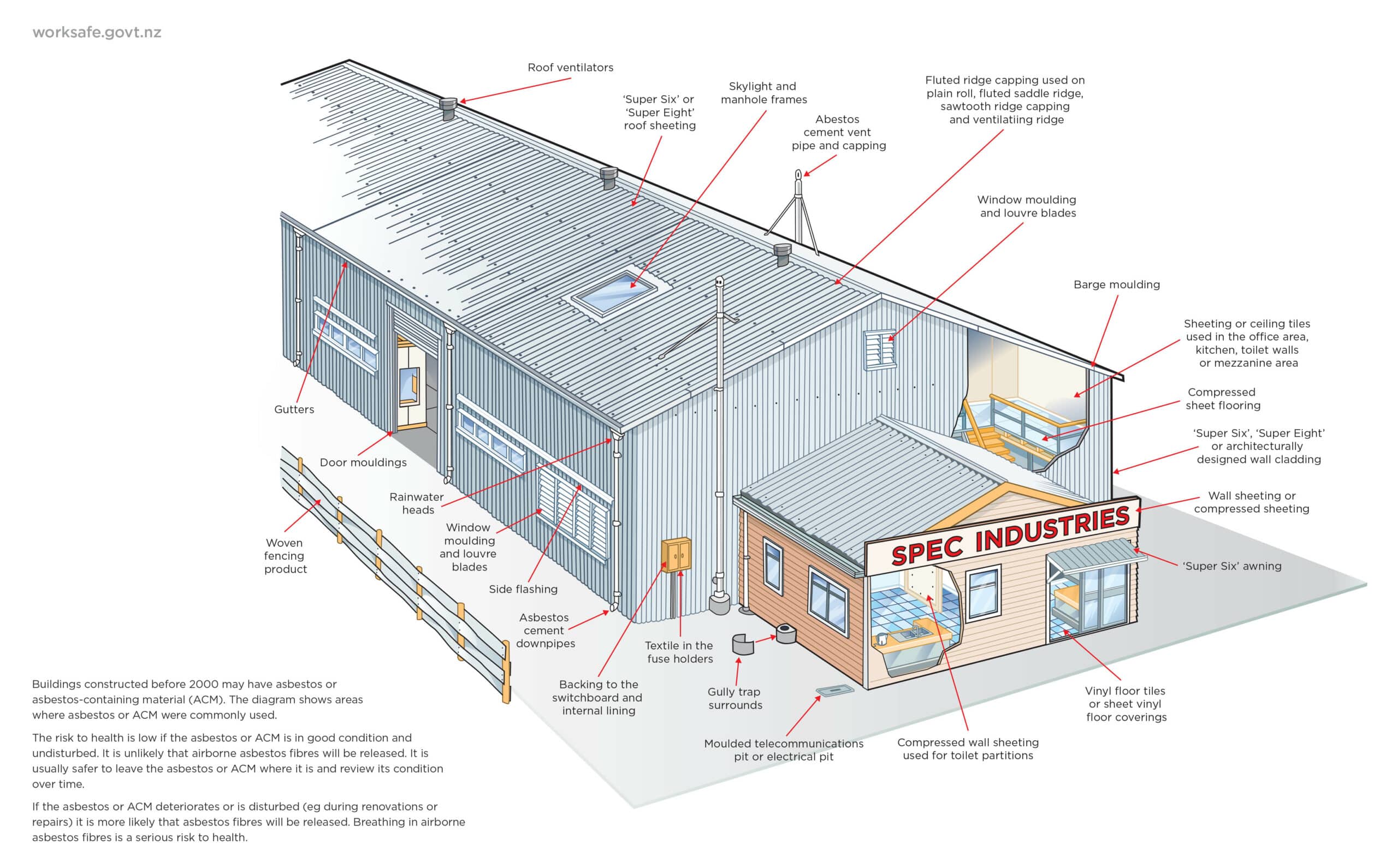What is Asbestos?
Asbestos is a naturally occurring mineral made up of many small fibres. These fibres are very strong and are highly resistant to heat, fire, chemicals and wear.
Why is Asbestos so popular in old buildings?
In the past, the special properties of asbestos made it popular for:
- asbestos-cement sheet cladding, roofing and drainage pipes
- backing material for floor tiles and vinyl sheets
- insulation board for thermal protection (eg, around fire places)
- textured ceilings and sprayed-on wall surfaces
- lagging for insulation around pipes, heaters and hot water cylinders
- vehicle brakes and clutches
- textiles
- spouting and guttering components
Asbestos was also used in household items, such as:
- oven gloves
- ironing board pads
- simmer mats for stoves
- fire blankets
Asbestos was mainly imported and used before the 1980s. Once the health risks of asbestos were known, its use was gradually stopped, and other materials replaced it. However, products and appliances with asbestos content may still be around, particularly in homes built before 1984
How can I tell the difference between friable and non-friable Asbestos?
When dry, Asbestos is considered friable if it can be crumbled, pulverized, or reduced to powder by hand pressure. If it can’t, it’s considered non-friable ACM. It’s possible for non-friable ACM to become friable when subjected to unusual conditions, such as demolishing a building or removing an ACM that has been glued into place.
What should I do if I suspect asbestos in my building?
A sample tested in an approved analytical laboratory is the most certain way to find out if a material contains asbestos. Contact your local asbestos consultants/assessors/laboratory to arrange a visit to the location to sample and test. Once completed a copy of the results will follow. For sampling in multiple areas, the consultants/assessors will undertake sampling for testing to the area.
If there is asbestos or asbestos-containing material (confirmed by laboratory analysis) in your home or the soil around your home,
The possible options are:
- leaving it as it is, disturbing it as little as possible
- sealing, encapsulating or enclosing it
- removing it
Asbestos-containing material on decorative ceilings, walls or flooring is not likely to be a health risk unless it is damaged, deteriorating or crumbly. If the asbestos-containing material is poorly bonded, damaged or deteriorating, fibres may be released into the air. This asbestos- containing material should be sealed, encapsulated, enclosed or removed.
What are the health risks of Asbestos?
Asbestos is a proven human carcinogen,and all forms of asbestos can cause cancer. The main way people are exposed to asbestos is by breathing in air that contains asbestos fibres. Asbestos causes cancer in a dose-dependent manner. The greater the exposure, and the longer the time of exposure, the greater the risk of developing an asbestos-related disease. No ‘safe’ lower limit of exposure has been identified with certainty – all exposure is thought to add to the overall risk of disease development – but the risk from a single, low-level exposure is considered to be extremely low. Keep exposure to asbestos as low as possible. Intact asbestos-containing material is not a risk merely by its presence. Potential health problems occur if asbestos fibres become airborne.Inhaling significant quantities of airborne asbestos causes:
- asbestosis (scarring of lung tissue)
- mesothelioma (malignant tumours, cancers that develop around the lungs or intestine)
- pleural plaques (thickening of membranes around the lungs)
- cancer of the lung, larynx and ovary
Symptoms of asbestos-related diseases include breathing difficulties and ‘scarring’ of the lung that can be detected by x-ray. Harmful effects following ingestion of asbestos have not been clearly documented. However it has been shown that few fibres are able to penetrate the gastrointestinal tract. Therefore the non-gastrointestinal effects from oral exposure to asbestos are unlikely. There is no consistent evidence that ingested asbestos is hazardous to health. Smoking can increase the risk of developing lung cancer following exposure to asbestos. The main way people are exposed to asbestos is by breathing in air that contains asbestos fibres. Small levels of asbestos fibres occur naturally in air, including as a result of weathering breaking down asbestos-containing materials, windblown soil from hazardous waste sites or deterioration of motor vehicle clutches and brakes. The levels of asbestos in dust and windblown soil may be higher close to degrading asbestos cement clad buildings, or former sites of such buildings, or a waste site where asbestos is disturbed or not properly covered.
Diagram showing the main diseases related to asbestos
Can I remove the Asbestos myself?
We strongly advise that you seek the help of a WorkSafe New Zealand licensed asbestos removalist such as ourselves to remove any asbestos containing material from your home as exposure to asbestos fibres is a danger to health.
A licensed removalist will take the necessary precautions and follow good work practices, as required by the Health and Safety at Work (Asbestos) Regulations 2016.




